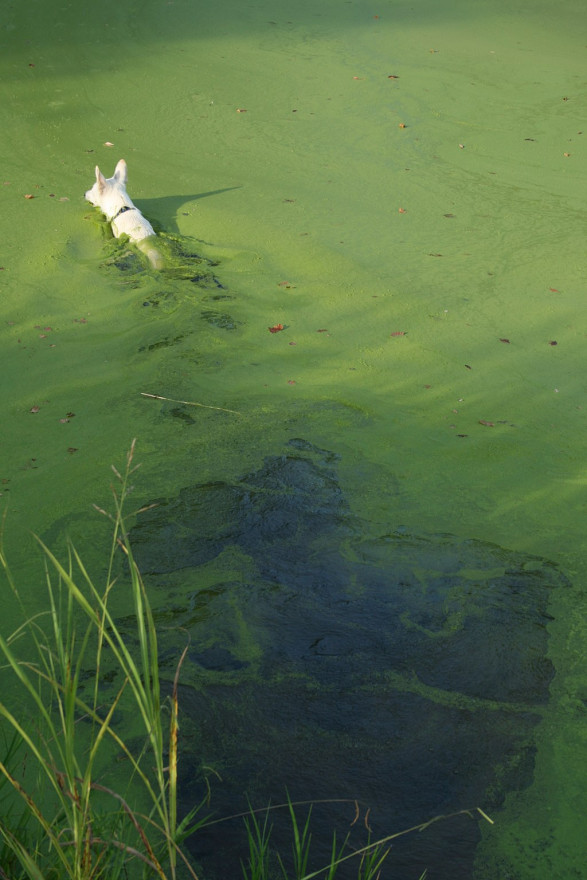
A pup swims in a pond of blooming algae. Could he be at risk? (Ildar Sagdejev/Wikimedia Commons)

A pup swims in a pond of blooming algae. Could he be at risk? (Ildar Sagdejev/Wikimedia Commons)
Nothing gets between a dog and her mission. My dog is no different. Juniper — Junie for short — is a border collie mix who spends her days darting around my parents’ backyard in Austin, Texas. She loves everyone she meets, and the sentiment is reciprocated; even our mailman slips her treats through the fence each day.
When I was growing up, one of Junie’s favorite spots to explore was the hike-and-bike trail around Lady Bird Lake in downtown Austin. Of course, every visit ended in a trip to the water. Junie’s dusty paws would bound down the familiar paths as she glanced back every few yards to make sure I was following behind. She would approach the lake’s edge warily, then gingerly step in to cool off from the scorching Texas sun and gulp down a refreshing mid-afternoon drink. When heading home she would leave a trail of muddy paw prints in our wake, refreshed and happy.
Today, though, a visit to the water may end differently.
In 2019, Austin’s lakes saw a sudden increase of harmful algae blooms (HABs) that tragically resulted in several dogs’ deaths and led to residents avoiding any contact between their pets and local bodies of water. No deaths — dog or otherwise — have been reported in Austin since 2019, but HAB events continue to occur across the city and pose a major threat to public health.
Austin’s HABs involve blue-green algae called cyanobacteria. This algae is naturally occurring but proves toxic in certain forms. In humans, the health effects of cyanotoxins may first appear as common cold or flu symptoms like fever, headache, and vomiting. Indicators in dogs include weakness, and respiratory paralysis, which can lead to death.
In late September of this year, toxic levels of cyanobacteria were found in one part of Barton Creek, a popular local swimming area. Though levels have since dropped to safer amounts, both Lady Bird Lake and Lake Austin, which sits northwest of the city down the Colorado River, have recently displayed concerning levels of toxic algae.
As human-induced climate change continues to threaten our day-to-day lives, HABs like Austin’s will only happen more often. Cyanobacteria thrive in environments with warm waters and high concentrations of carbon dioxide — two major consequences of global warming.
Increased water temperatures lengthen the growing season and widen the geographic range of algal blooms. Texas has already seen a 1 to 2 degree F increase in annual average temperature since the early 20th century. Scientists project that annual average temperatures in the Southern Great Plains will further increase 3.6 to 5.1 degrees F over the next 30 years, potentially worsening the effects of HABs over time.
Nutrient pollution is another related factor. This phenomenon occurs when nutrients mix with rain runoff and seep into bodies of water. Phosphorus and nitrogen are the most common pollutants and can result in excessive algae growth and enhanced toxicity. In turn, overgrowth of algae causes low oxygen levels in the water, affecting the entire ecosystem by killing fish and inhibiting aquatic plant growth.
In June, the Austin City Council unanimously voted to launch a pilot project to mitigate the effects of harmful algae using Phoslock, a material that chemically binds the phosphorus in water and sediment into a mineral form so that blue-green algae cannot obtain its nutrients. This five-year-long, $1,484,000 contract with the SePRO Corporation includes water collection and analysis as well as three Phoslock applications across 20 acres of water around Lady Bird Lake. City officials have not disclosed the status of the project since it was first announced.
Austinites should remain wary of areas displaying blue- or bright green-colored algae and stay up-to-date on the fluctuating risks of local bodies of water via the city’s monitoring systems. Now, on my visits home, I can’t explain to Junie why I now steer her away from the water’s edge on our walks, but at least I can take comfort in the fact that I’m doing my best to keep her — and myself — safe.